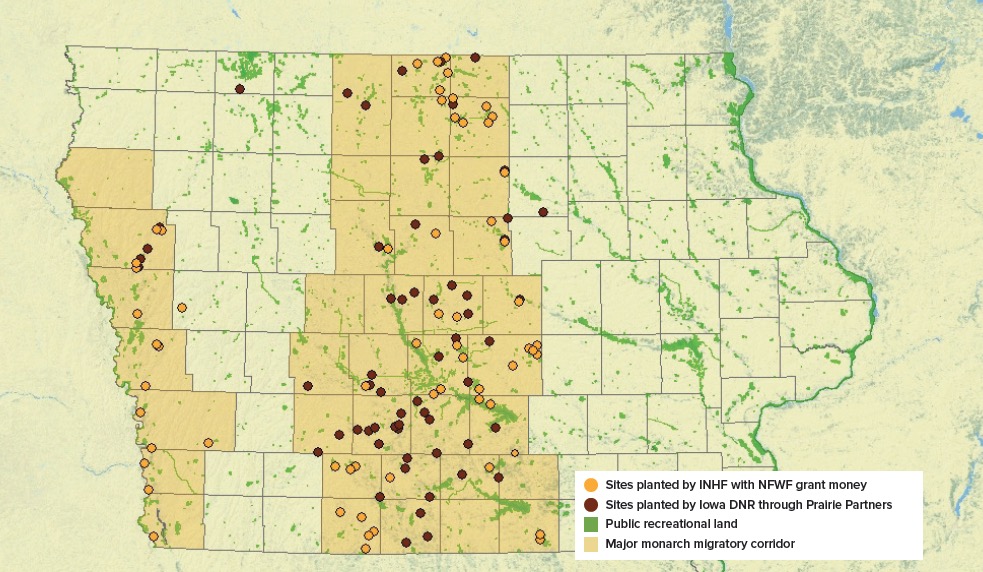INHF helps protect statewide Monarch habitat with pollinator partnership
By Andrea Piekarczyk on June 28, 2017 in Blog
The North American monarch is the only butterfly known to make a two-way migration as birds do.
.jpg) Harnessing air currents, thermals and a whole lot of milkweed power, monarchs travel as far as 3,000 miles to winter in the Sierra Madre Mountains of Mexico. There, they enjoy warmer temperatures, maybe a shot of good tequila and the company of several million other monarchs.
Harnessing air currents, thermals and a whole lot of milkweed power, monarchs travel as far as 3,000 miles to winter in the Sierra Madre Mountains of Mexico. There, they enjoy warmer temperatures, maybe a shot of good tequila and the company of several million other monarchs.
But the party is shrinking. According to the National Fish and Wildlife Foundation (NFWF), over the past 20 years, the monarch population has fallen by over 80 percent, mostly due to loss of critical breeding habitat. Iowa is smack dab in the middle of the breeding range — and also one of the areas with the largest losses of habitat.
In the winter of 2013, the realization set in that the monarch population couldn’t rebound without serious help. International conservation organizations and concerned individuals turned their attention to the issue of preserving the monarch and its miraculous migration.
In Iowa, the first efforts began with those working on private lands. Doug Helmers is the Iowa Private Lands Coordinator for the Partners with Fish and Wildlife Program. He and Kelly Smith, Private Lands Coordinator for the Iowa DNR, decided to combine their efforts and funds to begin restoring monarch breeding habitat. Their avenue for outreach was the Iowa DNR’s Prairie Partners program, which facilitates prairie plantings on private lands.
Helmers and Smith marked out a focus area of about 100 miles on either side of I-35 to begin their work, an area identified by the Monarch Joint Venture as a major migratory corridor. Helmers and Smith reached out to Iowa Natural Heritage Foundation and The Nature Conservancy (TNC) to jointly request grant money, focusing on the I-35 corridor, as well as the Loess Hills.
The proposal? Create or improve habitat for monarchs and other pollinators in ten 80-acre core sites, as well as 100-125 smaller sites that would make it easier for pollinators to find food or rest while traveling to a larger breeding site. The project was fully funded at $250,000 through a grant from NFWF, funded by the Natural Resource and Conservation Service (NRCS), Monsanto and the USFWS.
For those involved, it was thrilling to receive such substantial support. As Helmers observed, the grant has helped Iowa “really get out in front as far as monarch conservation is concerned. Iowa will be key in helping restore the monarch population.”
As word about the grant spread, project and partnership opportunities abounded. Bill Johnson, Natural Resource Biologist with the Iowa DNR, oversaw the majority of the plantings on state lands, improving and expanding the large habitat blocks that are the grant’s core sites. Multiple county conservation board projects received funding as well, as did pollinator gardens in state parks. In total, the grant will fund over 2,100 acres of prairie plantings on over 126 different sites.
 The most exciting part of the project, from Helmers’ perspective, is the speed of the partnership development. “All facets — landowners, county conservation boards, Iowa DNR, Fish and Wildlife Service — said ‘yes, this is what we need to do.’ There wasn’t a lot of fussing. It was a priority for everyone involved.”
The most exciting part of the project, from Helmers’ perspective, is the speed of the partnership development. “All facets — landowners, county conservation boards, Iowa DNR, Fish and Wildlife Service — said ‘yes, this is what we need to do.’ There wasn’t a lot of fussing. It was a priority for everyone involved.”
The success of the partnerships was undeniable. NFWF, recognizing the strength and commitment of those involved, granted another $150,000 to INHF in 2017. A third application has been submitted to work with partners in Linn, Johnson and Black Hawk counties along the I-380 corridor, including the Monarch Research Project, a nonprofit with the goal of establishing 1,000 acres of monarch habitat in Cedar Rapids, and 10,000 in Linn County.
For now, work from INHF’s second grant is just beginning, as the monarchs have begun their long journey back from Mexico. Thanks to the hard work of the Iowa conservation community, they are returning to a home that is a little better than they left it.